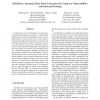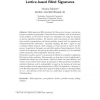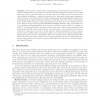324 search results - page 29 / 65 » A new signature scheme without random oracles |
ACNS
2003
Springer
14 years 1 months ago
2003
Springer
A (t, n) threshold signature scheme allows t or more group members to generate signatures on behalf of a group with n members, while any t−1 or less members cannot do the same th...
SP
2007
IEEE
14 years 2 months ago
2007
IEEE
In this paper, we present ShieldGen, a system for automatically generating a data patch or a vulnerability signature for an unknown vulnerability, given a zero-day attack instance...
ASIACRYPT
2010
Springer
13 years 6 months ago
2010
Springer
Blind signatures (BS), introduced by Chaum, have become a cornerstone in privacy-oriented cryptography. Using hard lattice problems, such as the shortest vector problem, as the bas...
CRYPTO
2005
Springer
14 years 2 months ago
2005
Springer
The Full-Domain Hash (FDH) signature scheme [3] forms one the most basic usages of random oracles. It works with a family F of trapdoor permutations (TDP), where the signature of m...
ESORICS
2009
Springer
14 years 9 months ago
2009
Springer
Abstract. Several generic constructions for transforming one-way functions to asymmetric encryption schemes have been proposed. One-way functions only guarantee the weak secrecy of...



